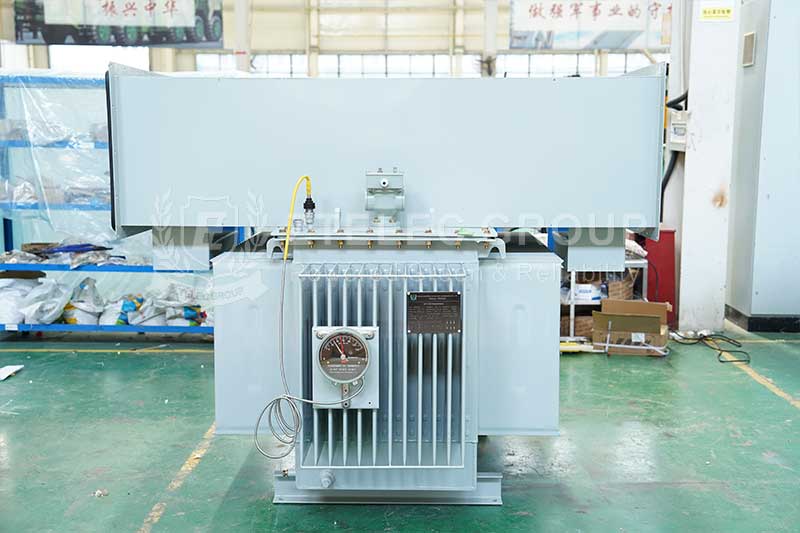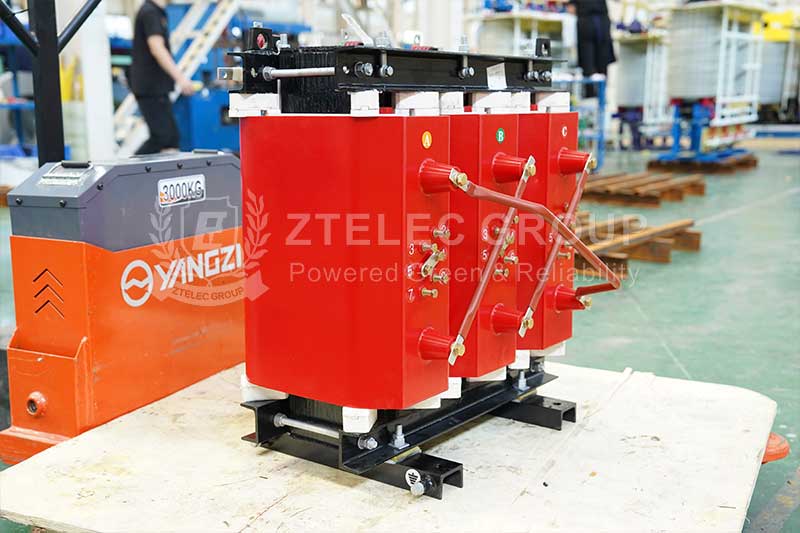1. What is an Oil-Immersed Transformer?
An oil-immersed transformer, as the name suggests, uses insulating oil as both the insulating medium and coolant. This type of transformer typically consists of a core, windings, an insulating oil tank, and auxiliary equipment. Its working principle involves conducting magnetic flux through the transformer's core, converting the input high-voltage electrical energy into the desired low or high-voltage electrical energy.1.1 Structural Characteristics of Oil-Immersed Transformers
The main structure of an oil-immersed transformer includes a metal oil tank, windings, and a core. The insulating oil has high insulation properties and good cooling characteristics, effectively reducing the operating temperature of the transformer. Additionally, both the core and windings of the oil-immersed transformer are submerged in insulating oil, a design that not only prevents moisture in the air from corroding the windings but also significantly reduces the noise produced by the transformer.
1.2 Advantages and Disadvantages of Oil-Immersed Transformers
Advantages:
Good heat dissipation: Due to the excellent thermal conductivity of oil, oil-immersed transformers can effectively dissipate heat under high load conditions, ensuring normal operation.
Strong overload capacity: Oil-immersed transformers have a strong overload capacity for short periods, allowing them to perform stably in emergencies.
Long service life: With proper maintenance, the service life of oil-immersed transformers can reach several decades.
Disadvantages:
Environmental hazards: If the insulating oil in the transformer leaks, it can cause environmental pollution, and the aging of the oil can also affect the transformer’s performance.
Large size and heavy weight: Compared to dry-type transformers, oil-immersed transformers are larger and heavier, requiring more space for installation.
Fire risk: Insulating oil has a certain degree of flammability, posing a fire hazard under high temperatures or short-circuit conditions.

2. What is a Dry-Type Transformer?
A dry-type transformer refers to a transformer that does not use liquids as insulating media, primarily relying on air or solid insulating materials (such as epoxy resin) for insulation and cooling. The structure of dry-type transformers is relatively simple, typically consisting of a core, windings, and insulating materials.
2.1 Structural Characteristics of Dry-Type Transformers
The core components of a dry-type transformer are a core made of stacked sheets and windings impregnated with solid insulating materials. This design allows air to circulate freely between the windings and the core, achieving good heat dissipation. Dry-type transformers are usually installed indoors due to their strong adaptability to the environment, making them suitable for densely populated areas and locations with strict fire risk control requirements.
2.2 Advantages and Disadvantages of Dry-Type Transformers
Advantages of Dry-Type Transformers:
High safety: Dry-type transformers contain no liquids, virtually eliminating leakage and fire risks, thus offering higher safety.
Environmentally friendly: The insulating materials used in the transformer generally do not contain harmful substances, causing no pollution to the environment.
Small size and lightweight: The design of dry-type transformers occupies less space for the same power rating, making them easier to install and transport.
Disadvantages of Dry-Type Transformers:
Relatively poor heat dissipation: Although dry-type transformers rely on air for cooling, their heat dissipation capability is inferior to that of oil-immersed transformers under high load conditions.
Weaker overload capacity: Due to limitations of the insulating materials, the overload capacity of dry-type transformers is generally lower than that of oil-immersed transformers.
Shorter service life: The insulating materials of dry-type transformers are prone to aging in high-temperature and humid environments, affecting their service life.

3. Applicable Scenarios: Oil-Immersed Transformers vs. Dry-Type Transformers
The different characteristics of oil-immersed transformers and dry-type transformers make them suitable for different scenarios:
Oil-immersed transformers are suitable for high-voltage, high-power electrical systems and are widely used in large power plants, substations, and outdoor high-voltage transmission lines. Their excellent heat dissipation and overload capacity allow them to adapt to varying load demands.
Dry-type transformers are more suitable for urban buildings, power distribution, and places where strict fire risk control is required. Their compact size and ease of installation make dry-type transformers particularly applicable in space-constrained areas, such as underground parking lots, hotels, and hospitals.
There are significant differences between oil-immersed transformers and dry-type transformers in terms of structure, working principles, advantages and disadvantages, and applicable scenarios. Choosing the appropriate type of transformer is key to ensuring the safe and efficient operation of power systems. In the future development of power technology, transformer products that balance aesthetics and performance will continue to emerge to meet the needs of various users. Whether it is an oil-immersed transformer or a dry-type transformer, understanding their characteristics will help electrical engineers and technicians make the best choices in practical applications.








Leave A Comment